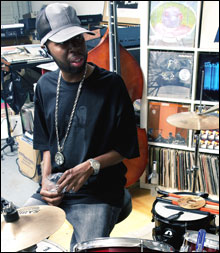 Hip-hop icons never just die. They fall in battle, tumble from the sky, or drown in addiction. The robbery of their lives is apparent, obtrusive, cinematic. Strange, then, that one of hip-hop’s greatest, James Yancey (a/k/a Jay Dee, best known as J. Dilla), would pass so surreptitiously. His death was wholly unassuming. A multi-year battle with a blood sickness and then a diagnosis of lupus. A hospital stay last fall, a brief recovery, European performances in a wheelchair. And, finally, a quick death that descended on the 32-year-old producer while he was cradled in his mother’s embrace.
Hip-hop icons never just die. They fall in battle, tumble from the sky, or drown in addiction. The robbery of their lives is apparent, obtrusive, cinematic. Strange, then, that one of hip-hop’s greatest, James Yancey (a/k/a Jay Dee, best known as J. Dilla), would pass so surreptitiously. His death was wholly unassuming. A multi-year battle with a blood sickness and then a diagnosis of lupus. A hospital stay last fall, a brief recovery, European performances in a wheelchair. And, finally, a quick death that descended on the 32-year-old producer while he was cradled in his mother’s embrace.
Dilla’s passing, on February 10, came just three days after his birthday and the release of his second solo album, Donuts (Stones Throw). Since leaving his original group, Slum Village, Dilla had established himself as a producer/rapper. But Donuts is Dilla distilled: all beats. Originally conceived as a beat tape and then produced on his hospital bed last fall, it’s exactly the forward-thinking, experimental showcase you’d expect from an artist with the end in view. Dilla decimates the hip-hop mold, motoring through electric guitars and muted percussion on “Workinonit,” æthereally serenading us on “Time: The Donuts of the Heart,” and reflipping his own verses on “Dilla Says Go.” With only a single track crossing the two-minute mark, Donuts is a fitting bookend to his career, and a reminder that Jay Dee didn’t make music, he made movements.
His résumé speaks miles. After hooking up with Q-Tip in the mid ’90s, he became part of the legendary Unmah production team that cemented A Tribe Called Quest’s classic status with cuts like “Get a Hold,” “Find a Way,” and “Stressed Out.” On his own, he built trademark cuts for Pharcyde (“Runnin,’ ” “Drop”), De La Soul (“Stakes Is High”), and the Roots (“Dynamite”). His credits include all of Slum Village’s early work, Q-Tip’s Amplified (1999), Common’s Like Water for Chocolate (2000), portions of D’Angelo’s Voodoo (2000), and his Jaylib collaboration with LA beatsmith Madlib in 2003. If it knocked in the late ’90s, Jay Dee probably had a hand in it.
There’s no greater testament to his paradigm-shifting ability than the cult of beat collectors who grew up around him. When Pharrell Williams shouted out the producer on BET’s 106 & Park in 2004, he confirmed to the public what Dilla followers had known for years: Jay Dee was the producer’s producer. Kanye West shared that conviction: he left two spots for the Detroit producer on Common’s Grammy-nominated Be. Their respect for Dilla reflected just the top end of a complex of fans and producers who’d been swallowing his music wholesale for years. Thanks to file-sharing networks, followers could search the Web for new, unreleased, and unlabeled Dilla material.
The “Dilla sound” is distinct: drums chopped finely, cooked al dente, and presented so big they stand alone. Dilla swam through genres, blending soul and funk into hip-hop to create beats that hit with a surreal consistency. DJ House Shoes, a long-time Dilla friend, put it bluntly when we spoke back in December. “Why is there a cult of Jay Dee? Why do people smoke crack? You’re not gonna get that feeling off anyone else’s music. If anybody’s lacking inspiration, then a Dilla beat CD on the net would give them all they need to get their ass back in the studio.”
___
On the Web:
J. Dilla: http://www.stonesthrow.com/jdilla/